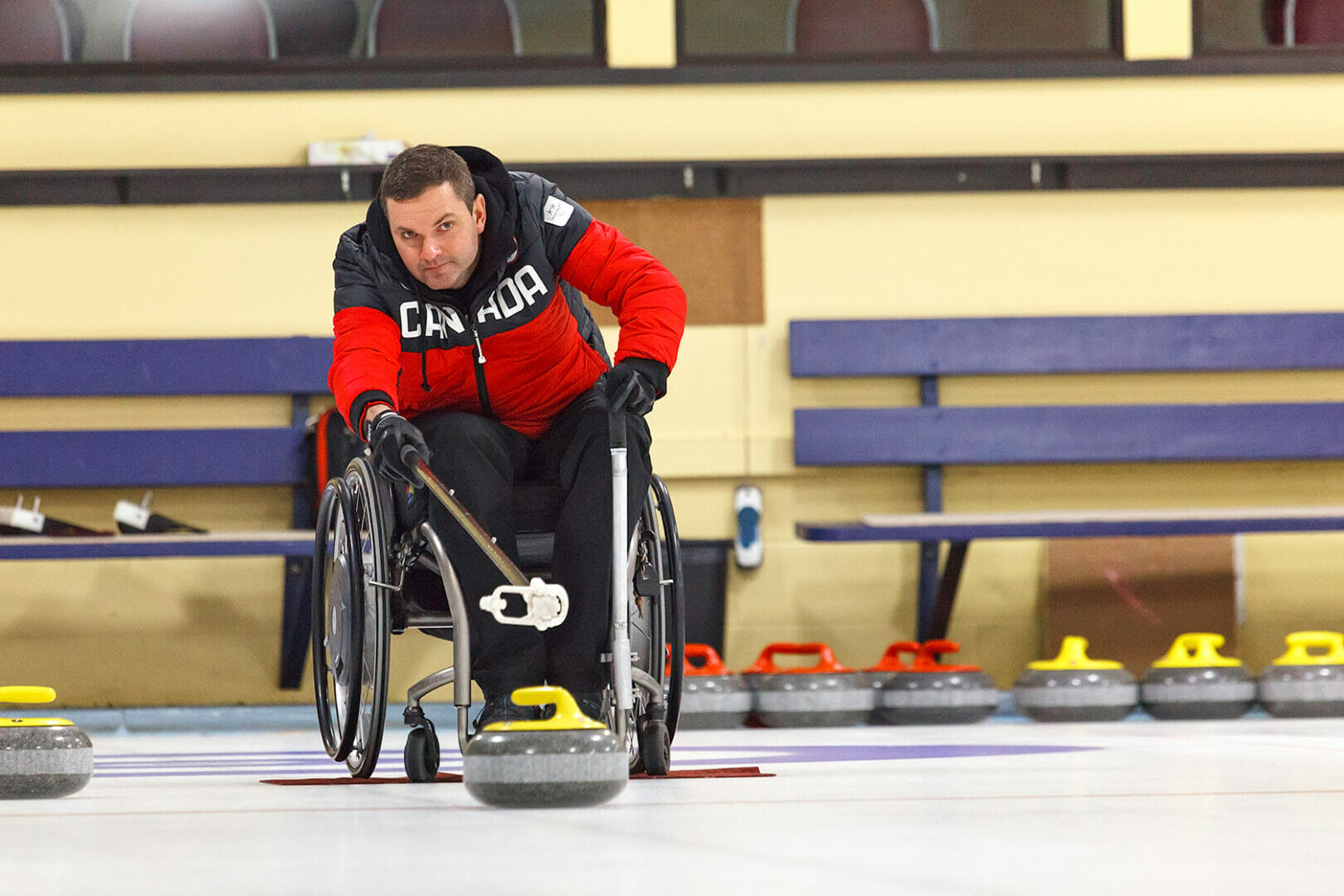Use of technology in the world of sports is improving at a rapid rate. New types of data, coupled with advanced engineering tools, allow for more in-depth analysis of the human body as it pertains to specific movements and tasks. As a result, motions can be refined and equipment improved to help athletes maximize their abilities and performance. John McPhee, a professor of Systems Design Engineering at the University of Waterloo (UW), has overseen several studies on the motor function of Paralympic athletes. McPhee, who focuses on modelling the interactions between athletes and their equipment to maximize athletic performance, relies on MapleSim in his research and project development. MapleSim allows his team to explore millions of design possibilities to determine the ideal solution for each subject.
McPhee and his team recently worked with the Canadian Paralympic Wheelchair Curling team to design a better wheelchair curling shot. McPhee’s team, led by Brock Laschowski, a PhD student in the Department of Systems Design Engineering at UW, conducted a study of the motor control of Paralympic wheelchair athletes, using MapleSim to model their wheelchair curling shot. Laschowski’s research is paving the way for custom-designed wheelchairs that are designed specifically for individual athletes and their respective neuro-musculoskeletal systems. The human biomechanical model consists of rigid body segments characterizing the torso, head and neck, upper arm, forearm, and hand, as well as representative hip, shoulder, elbow, and wrist joints, all of which were modeled as revolute kinematic pairs containing biofidelic viscous damping quantities. MapleSim was subsequently used to perform analyses on the inverse dynamics of the multibody system model with experimentally measured joint and stone kinematic data. “We’ve been working with Team Canada for a few years now and it was extremely satisfying to see them win the bronze medal at the Paralympic Games in South Korea,” McPhee said. “We’re hoping for gold medals in the years to come.”
The study also gave rise to the idea of a curling end-effector, a device to help wheelchair curlers improve control over their shots. The device attaches to the end of the curler’s stick and provides greater command over the stone by pulling it back prior to release. Two more members of McPhee’s team, University of Waterloo students Borna Ghannadi and Conor Jansen, began the end-effector project in 2016 at the request of Mark Ideson, the skip for the Canadian men’s Paralympic curling team and winner of Paralympic gold (2014) and bronze (2018) medals. After being modeled in MapleSim, an initial prototype was built, which has undergone several trials and adjustments since then. The device is now on its 7th iteration – appropriately named Mark 7 – and is close to being a finished product. “It’s been modified quite a few times because it turned out to be more of a challenge than anyone thought,” Ideson said. “But we knew something could be created if we were able to get the right people on it. John and his team have come up with a great design.”
Currently, wheelchair curlers use a device that keeps the stone static before it’s thrown. Having the ability to pull back on the stone and break the friction prior to release will provide great benefit to the curlers. Certain conditions in curling, such as warm or sticky ice, or a freshly sanded stone, can cause the stone to catch or wobble on release, which leads to decreased accuracy. The Mark 7 enables the shooter to slightly pull back on the stone at the release point, thus breaking the inertia. “When you can only push forward, if the ice conditions aren’t perfect, you’re throwing at a different speed every time,” McPhee said. “If you can pull the stone back and then go forward, you’ve broken that friction and your shot is way more repeatable. This should really make the game more interesting.”
The objective was to design a mechanism that not only allowed curlers to pull back on the stone, but also had a release option with no triggers on the curler’s hand. The Mark device screws on to the end of the curler’s stick, and is designed to rest firmly on the curling handle. It can be tightened or loosened as required to fit the handle properly and provide curlers with greater control over the stone. Once the curler selects their shot, they can position the stone accordingly, slide the stone forward and pull back at the release point to separate the device from the stone.
“The increased speed and accuracy of MapleSim’s multibody dynamic simulations, made possible by the underlying symbolic modelling engine, enabled the team to spend more time on system design and optimization,” said Laschowski. “Though several multibody system algorithms have been commercialized, these model codes are limited to engineering mechanical systems and don’t necessarily support features characteristically involved in biomechanical applications like muscle mechanics and activation dynamics, non-ideal human joint geometries, and biomechanical impact dynamics.”
Contrasting the aforementioned multibody software, MapleSim employs principles of mechanics with linear graph theory to produce unified representations of the system topology and modelling coordinates, Laschowski said. “The system equations are automatically generated symbolically, which enables us to view and share the equations prior to a numerical solution of the highly-optimized simulation code. MapleSim’s algorithms also support the incorporation of electromechanical components, should we eventually decide to incorporate wearable sensor technology into the system model.”
Mark 7 could have significant ramifications in the curling world. Shooting accuracy across wheelchair curling is currently around 60-62%, according to Ideson. If the curling association allows the use of new technology, like the Mark 7, that number could grow to 70 or 75%, he said. “If we can add accuracy, it’s going to improve the game overall,” Ideson said. “The ability to pull back prior to release really eliminates some instability. A device like this really levels the playing field.”
After a recent practice session, Ideson said the device feels good and he and his team are looking forward to having an opportunity to use the finished product. “It’s really exciting because we hope the game can improve with innovations like this,” he said. “It should help improve the level of curling across the world.”
McPhee and his team have a strong history of improving technology driven enhancements to sports projects using MapleSim. They are currently working with Team Canada Wheelchair Basketball to model the wheelchair push in MapleSim, which will allow them to test various wheelchair configurations and determine which designs best optimize performance and speed. They have also worked with Cleveland Golf/Srixon to model a driver in MapleSim to better understand the effect of different club lengths and weights on performance, and with Hockey Robotics to develop SlapShot XT, a robot designed using MapleSim that allows manufacturers to test their hockey stick designs to improve performance and eliminate breakage.
McPhee, who has been working in sports engineering since the 1980s, said MapleSim is ideally suited to modelling athlete and equipment performance. “Its multi-domain capabilities allow us to model humans, mechanical equipment, electrical actuators and feedback sensors, all within a single environment. That greatly accelerates our model-based design and control efforts,” he said. “We’re using MapleSim to improve performance in many sports. Our list of research partners is very long and continues to grow longer. We are excited for what the future brings.”







